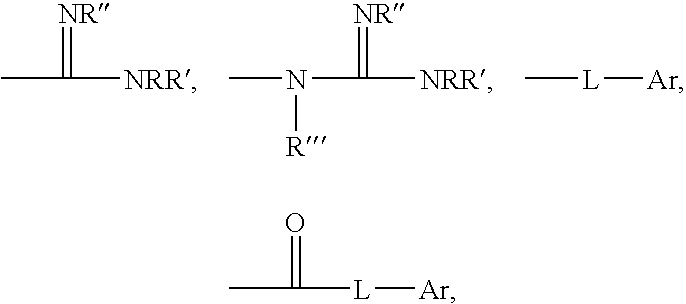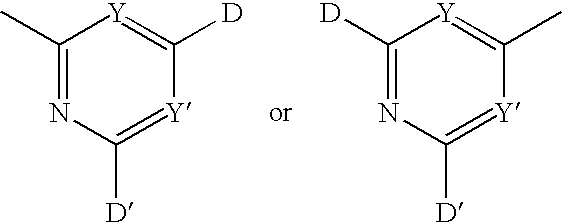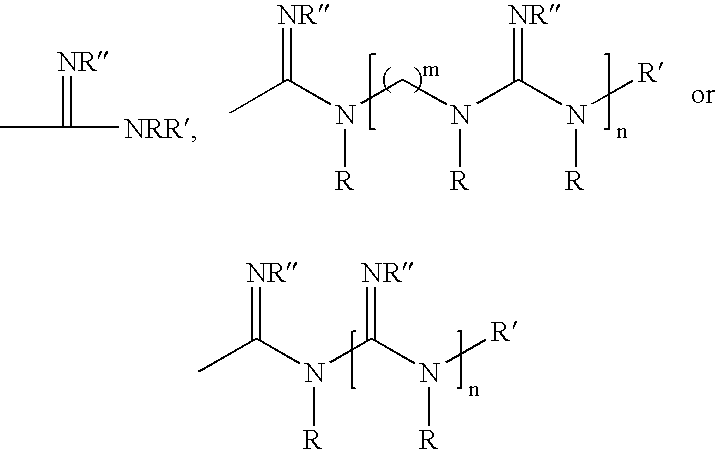Polymeric anti-microbial agents
- Summary
- Abstract
- Description
- Claims
- Application Information
AI Technical Summary
Benefits of technology
Problems solved by technology
Method used
Image
Examples
working examples
Example 1
[0176] To a solution of the 1.7 grams of a polyethylenimine polymer in water at 80° C. is added 6.8 grams of benzyl bromide and 5.6 grams of potassium carbonate in 6 mL methanol and 7 mL water and the mixture is stirred until no benzyl bromide is detected by thin layer chromotography (TLC). The solvent is evaporated, the residue is treated with 40 mL of ethanol at reflux for 15 minutes, the mixture is cooled and filtered, and the resulting solution is concentrated and dried under vacuum. Hexane, 40 mL, is added and the mixture is heated to by reflux giving 2 phases which are separated, the oily layer containing the polymer is separated from the hexane layer and evaporated to dryness under vacuum to give 3.22 grams of benzyl substituted polyethylenimine as a yellow solid. Analysis by NMR reveals 1.3-1.5 equivalents of benzyl groups per ethylenimine monomer group and a 5-7% of benzyl alcohol as by-product.
example 2
[0177] Polyethylenimine is also benzylated by heating to reflux a mixture of 5 grams of polyethylenimine, 10 grams of benzyl bromide, 3.8 grams of potassium hydroxide and 50 ml of ethanol until no benzyl bromide can be detected by TLC. The reaction mixture was filtered and the solution was concentrated and dried under vacuum to give 7.8 grams of benzyl substituted polyethylenimine as a yellow syrup.
example 3
[0178] A mixture of 5.6 grams of polyethylenimine and 2.9 grams cyanamide and 100 mL toluene are stirred at reflux for 12 hours. The solvent is removed under vacuum to leave 8.4 grams of a guanidine substituted polyethylenimine as a solid, structure confirmation by 13C NMR.
[0179] Using a variant of the general procedure of Example 1 or 2, polyethylenimine polymers are reacted with the following halides (RX) to generate the corresponding N-substituted polymer. The halides are items of commerce or readily prepared via known means.
Ex-RX perSubstitutionampleRXmonomerper monomer40.250.2450.250.2560.250.2570.50.3680.50.3890.50.45100.50.25 eq1110.23 eq120.50.49 eq1310.60 eq140.250.23 eq150.50.44 eq[0180] RX is the halide used [0181] RX per monomer is the ratio of halide used for each ethylenimine monomer unit (—CH2-CH2-NR—) of the starting polymer [0182] Substitution per monomer is the percentage of polymer backbone N atoms substituted in the resulting product
[0183] Using a variant of ...
PUM
| Property | Measurement | Unit |
|---|---|---|
| incubation time | aaaaa | aaaaa |
| hygroscopic | aaaaa | aaaaa |
| log reduction | aaaaa | aaaaa |
Abstract
Description
Claims
Application Information
 Login to View More
Login to View More - R&D
- Intellectual Property
- Life Sciences
- Materials
- Tech Scout
- Unparalleled Data Quality
- Higher Quality Content
- 60% Fewer Hallucinations
Browse by: Latest US Patents, China's latest patents, Technical Efficacy Thesaurus, Application Domain, Technology Topic, Popular Technical Reports.
© 2025 PatSnap. All rights reserved.Legal|Privacy policy|Modern Slavery Act Transparency Statement|Sitemap|About US| Contact US: help@patsnap.com



